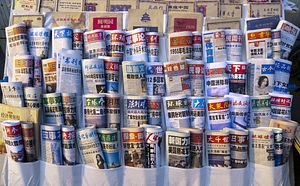Xi Jinping announced on Monday that China plans to build “new-type media groups that are strong, influential, and credible.” Xi also stressed that these media groups would combine traditional media with new media forms, including social media. The planned reform for China’s media was one of several issues (including reforms to China’s state-owned enterprises) discussed at Monday’s meeting of the central leading group for reform.
China Daily had more details on the proposed media reform in an article that described Xi’s idea “as opening [a] new chapter for the industry.” Xi envisions the new mainstream media groups as “encompassing multiple communication platforms.” According to Xi, traditional news outlets and organizations relying on new media “should complement each other in terms of content, channels, platforms, operations and management.” As one Beijing journalist told China Daily, the new reforms are aimed at blending the best aspects of traditional and new media: the credibility of traditional print media with the timeliness and accessibility of Internet-driven news.
Since Xi took office, China has been trying to increase the credibility of its official news outlets, such as the Xinhua news agency, even while stepping up control of non-traditional “citizen journalism” on the Internet. Crackdowns on online rumors and requirements for real-name registration to use microblogs and instant messaging apps are designed to increase government control over what becomes “news” on social media outlets.
At the same time, however, China has shifted tactics with its state-owned media outlets. Instead of imposing news black-outs on potentially embarrassing stories (as China attempted to do with the 2011 Wenzhou train crash), Xinhua and other state-owned outlets now often break news via their own social media accounts. In a recent example, People’s Daily’s official Twitter account tweeted out a picture of a bloodied man, with the caption “An old man got seriously beaten by urban magt officers Mon in Xuzhou City, Jiangsu, after he questioned their act.” Pictures of chengguan brutality often circulate on China’s social media and face deletion from censors; today, People’s Daily itself carried the image. Instead of covering up stories, China’s government seems to have adopted the strategy of getting out in front of and “spinning” news — a skill that Western politicians have been honing for decades.
Xi’s announcement reflects a growing concern at elite levels that Party messaging still needs further tweaking. Song Jiangwu, the dean of the journalism school at China University of Politics and Law, told Financial Times that Xi’s comments “are a sign that senior officials in the Communist party are concerned … about the influence of traditional media forms and their ability to communicate.” Indeed, for the Party, media messaging is serious business. Xi’s anti-corruption campaign is motivated at least in part by a perceived need to shore up the Party’s reputation among the Chinese people.
To do this, China’s state-controlled media outlets will need to ensure their credibility. If China can succeed in making Xinhua, People’s Daily and the rest trusted brands, it might also help solve the problem of “online rumors.” Sources from Tea Leaf Nation to Chinese blogger Yang Hengjun have noted that a lack of trust in Chinese state-run media is driving the circulation of unverified rumors online.
However, when Xi speaks of building an “influential” Chinese media, he is likely focused not at home but abroad. Chinese officials (and official media) often complain bitterly about unfair and biased reporting about China in foreign news outlets. Unfortunately for the Chinese government, foreign (and mostly Western) news media has become an international force. To combat this, China has made a concerted effort to balance out “biased” reporting with its own state-controlled international publications.
The English-language China Daily, created especially for foreign audiences, is the most obvious example. The paper, which also calls itself the “window to China,” circulates in the U.S., Canada, Europe, and Africa. In addition, China Daily produces a monthly “China Watch” section that is included as paid supplement in the Washington Post, New York Times, Wall Street Journal, International Herald Tribune, and The Daily Telegraph. The paper makes no pretense about its goals: according to its website, China Daily’s mission is “helping the world know more about China and the country’s integration with the international community.” It provides foreign readers with China’s officially-sanctioned viewpoint on both domestic and international affairs.
Projects like China Daily and (presumably) Xi’s new media groups are seen by an important foreign policy initiative. Increasing the perceived credibility and influence of Chinese media is a necessary step toward improving China’s international image, which is turn is a crucial part of boosting Chinese soft power. It’s questionable whether China can succeed in its quest without loosening tight government restrictions on reporting — China was ranked 175th out of 180 countries in Reporters Without Borders’ 2014 World Press Freedom Index. But Xi seems determined to try nonetheless.

































